Menu

In 2015, irrigation using an enormous 42 percent of the USA’s freshwater stood out. This shows we must use water in farming more wisely. With challenges like growing populations, climate change, and various needs for water, finding better ways to manage our water is key. Using water efficiently in farming not only grows good crops but also saves a vital resource for our planet.
This guide will look at different ways to save water in agriculture. We’ll discuss methods like drip irrigation and making smart plans for when to water. These techniques help us use water better, look after the soil, and protect water for the future.
As we ask more of our farms and find our water sources shrinking, we must look at how we use water wisely in farming. In 2015, 42 percent of our country’s fresh water was used for farming needs. This shows us why we need to focus on using water in a way that helps crops grow without harming the environment.
Farms using water better is now key. They take up to 70 percent of our fresh water. Places like Nebraska and California are big on using water to grow crops, with millions of acres needing irrigation. But, over the years, we’ve gotten smarter about how we water, using less water per acre.
Corn and soybeans are particularly thirsty, needing lots of water on millions of acres. Efficient water use is crucial to keep farming sustainable in such cases.
Using water efficiently in farming is vital for growth and to keep our natural water safe. The use of high-pressure water systems has greatly improved our water use in the western U.S. About 72 percent of these farms now use them, up from 37 percent in 1984.
There are many ways to make farming friendlier to our water supply. These include mulching, planting different crops together, and collecting rainwater. These steps save water and energy. They move us closer to farming in a way that’s good for the planet. With the right approach and keeping an eye on how things are doing, we can use water better. This way, we ensure our farms can keep growing without harming nature.
Drip irrigation is a standout in water-saving for farming. It efficiently boosts crop growth. This system lowers water waste by directing water straight to the plant roots.
Drip systems are a good investment, costing from $500 to $1,200 per acre. They increase crop harvests and cut down on water use. These improvements are seen in onions, lettuce, and other crops. The method reduces water loss and the spread of nutrients, making water and fertilisers work best.
Filters in the system, including sand media filters, are crucial for clean water. They must clean water from natural sources well. To do this, filters use a specific grade of sand and mesh size. They also stop very small particles from blocking the system. Including screen filters is also wise to keep everything running smoothly.
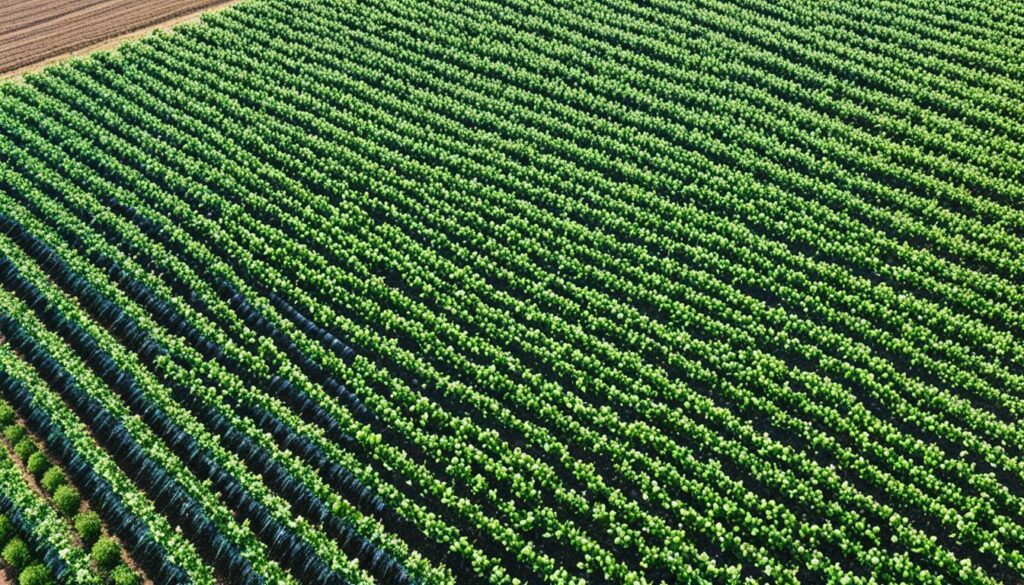
At Agrícola El Porvenir in Mexico, Daniel show the success of drip systems. In a dry place like Mexico, water-saving tech is vital. Drip irrigation has cut water waste and improved crop quality on his family’s farm.
Markets want top-quality veggies, even in dry times. Drip irrigation helps Daniel meet these needs, saving his crops from drought damage. He keeps producing well, avoiding big losses.
Daniel uses modern tech, like shading nets, to keep his crops safe. He works with water experts to stay ahead in farming. His ties with Dr. José Quintero have led to smart farming choices, including using drip systems to save water and protect crops.
Daniel tracks water use with meters, spotting problems fast. This careful use of water promotes good growth in his fields.
Recently, precision farming has become a key practice in modern agriculture. Digital technologies are at its heart. They have boosted farmers’ production by 4%. Also, they cut down on things like fertilisers and herbicides use. This has led to a 6% drop in fossil fuel use and a 4% cut in water usage.
Thanks to Real-Time Kinematic (RTK) corrections, farm work is much smoother. Otherwise, farmers might need to buy a $4,000 base station. Or spend nearly $500 a month on drone services. By using RTK systems, checking fields can now be done in just 30 minutes. This process used to take days. RTK networks, like Point One Polaris, offer farm maps at a cheap fare of $50 per month. These services are available in several regions around the world.
Advanced tools like Variable Rate Technology (VRT) ensure inputs like seeds and fertilisers are applied accurately. This helps in sustainable farming. By adjusting inputs based on different field needs, we use resources better and reduce waste.
Precision farming is especially great for small farms. With drones and satellite data, small-scale farmers can control their farms from afar. They get real-time updates on their crops and soil. This helps in making smarter decisions and improves efficiency. Folio3’s technology offers savings, more flexibility, and better output.
Here are some compelling statistics:
| Metric | Impact |
|---|---|
| Increase in Production | 4% |
| Reduction in Fertiliser Use | 7% |
| Decrease in Herbicide Usage | 9% |
| Reduction in Fossil Fuel Use | 6% |
| Water Conservation | 4% |
Precision farming’s market growth is predicted to go over 15 billion dollars. 61% of North American farmers believe it will increase yields by 2024. Its adoption has brought significant improvements, like better placement of fertilisers and less use of herbicides. The average maximum benefit per acre is almost $90. This shows the strong future of digital technologies in farming.
Water is key for farming and takes a big part of the world’s fresh water. It’s crucial to use water wisely in agriculture. To do this, we need to capture water well and store it right. These actions make sure there’s enough water, even when there’s little rain.
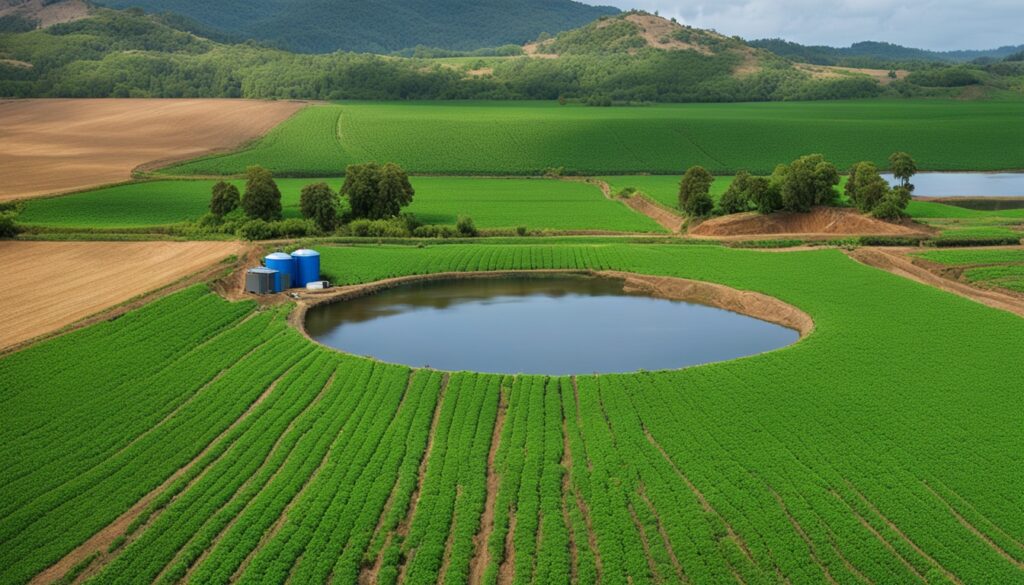
Many ways are there to catch rainwater. We can build reservoirs and ponds, and use rainwater systems. These methods help keep water steady. Using drip irrigation is also smart. It saves water by sending it straight to the plants’ roots. This way, water is used well and plants grow strong.
Stored water is a lifeline during droughts. It eases the strain on scarce fresh water. Reservoirs and ponds act as a safety net against unpredictable weather. They make sure plants get enough water, even in droughts. These methods are crucial for fighting drought effects on farming.
| Method | Benefits |
|---|---|
| Reservoirs | Ensure long-term water availability and mitigate drought impacts |
| Ponds | Provide supplemental water sources and enhance irrigation efficiency |
| Drip Irrigation | Reduces water loss, improves plant health, and conserves water |
| Rainwater Harvesting | Captures rainfall, reducing reliance on freshwater resources |
Getting irrigation right is key to using water well on farms. We need to know how much water different crops need. Then, we use high-tech tools to make sure we use water smartly. This helps the farm stay productive and protect the environment.
Knowing exactly how much water crops need is very important. It all starts with checking the type of soil, what we’re growing, and the weather. In California, researchers are using special sensors to see how much water each plant needs. This helps them manage water on vineyards and orchards better.
New tech is changing how we manage water in fields. Tools that check soil moisture and predict the weather are a big help. In Nebraska, most of the big farms use high-tech rotating water sprinklers. These systems cover a lot of land and use water very efficiently.
Scientists at NASA are even looking into how to grow food in space. Back here on Earth, researchers in California and Arizona are testing a new way to measure water use in crops. They use a special satellite and it seems to be doing a good job. It can help farmers save water and still grow good crops.
ARS scientists in Beltsville, Maryland, developed a biodegradable, hydrogel-based “artificial soil” supporting a full 14-day growth cycle for microgreens, equivalent to conventional production yields without daily watering requirements.
Last year, there was a test on a maize field. It showed a new app for managing water worked really well. The maize got less water but still did very good. This means we can save water on crops without losing any food.
The following table illustrates comparative data on water use efficiency achieved through various irrigation scheduling practices:
| Irrigation Scheduling Method | Water Used (mm) | Grain Yield |
|---|---|---|
| IrrigaNet | 80 | High |
| Third-Party Product | 133 | High |
| Control Group | 106 | High |
This study shows that good water management can boost crop yield without using more water. It’s very helpful for areas where water is not always easy to get. It keeps farms growing and the land healthy.
Bettering soil health with sustainable farming helps save water. It aids crops to grow. Also, it makes soil tough against being washed away or wearing out. Compost, mulch, and careful tillage are key in this effort.
Using compost and mulch in farming makes soil better and richer. Rich soil can keep more water and give more nutrients to plants.
Wind and water are kept from eroding the soil by these. Water soaks in more easily, making the soil strong. This helps farmers keep their soil full of moisture and nutrients.
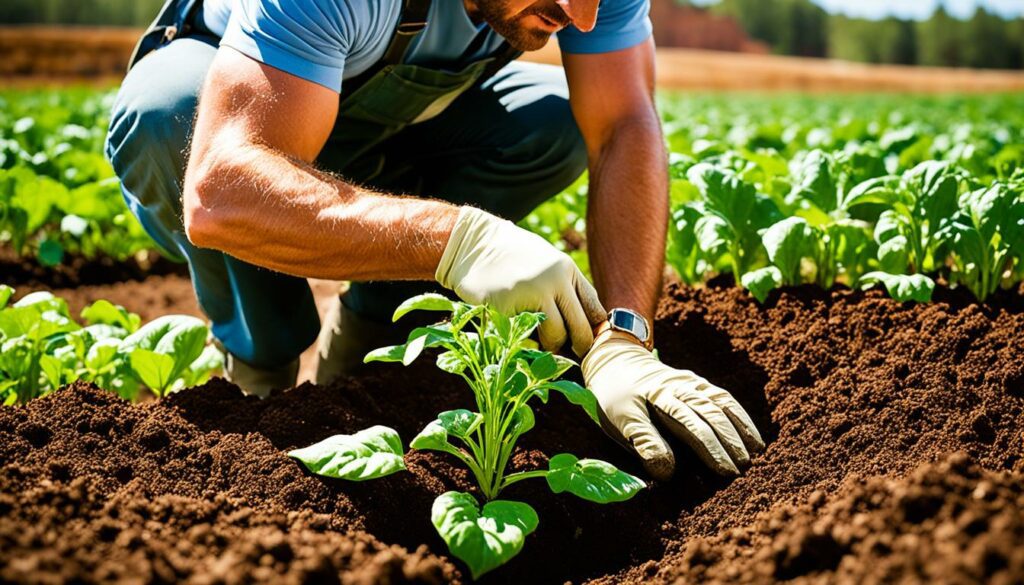
Conservation tillage is vital. It reduces harm to the soil’s nature. Without this, the soil might not work well, letting water flow less and harming plants and the soil’s life.
Using conservation tillage makes soil better at many things. It lets water in, keeps the soil packed, and helps the soil’s life stay healthy. Also, having many types of plants helps the soil and reduces problems with plants.
| Soil Health Strategy | Benefits |
|---|---|
| Using Compost and Mulch | Increases water-holding capacity, controls erosion, and enhances soil structure. |
| Conservation Tillage | Improves water infiltration, supports soil aggregation, and maintains soil food web integrity. |
| Cover Crops | Provide continuous root exudates, support soil microbial communities, and reduce erosion. |
Dry farming is a key solution for regions short on water for farming. It can save about 80% of water used in agriculture. This is a big deal because a lot of the US’s vegetables come from California.
It’s interesting to note that in 2022, 26 of California’s 58 counties were perfect for dry farming. This was because they had over 50 centimetres of precipitation. Farmers in these areas make the most of the water from winter or snowmelt. They do this to grow their crops without using much irrigation. This helps save water and stop about 25% of it from evaporating during irrigation.
Produce from dry farming might be smaller, but it has its perks. Winter squash grown this way produces more sellable fruit after storage. This is compared to squash that gets regular watering.
Farmers use techniques like tilling deep, adding mulch, and using organic materials. These methods help their soil hold water better. This is crucial for growing crops when water is scarce.
Choosing the right plants is also important. Drought-resistant plants and heirloom seeds are preferred. They can survive with less water. Using less water when planting also matters. Methods like drip irrigation help keep the soil moist. They also stop water waste.
Rainwater isn’t wasted in dry farming. Farmers build structures like swales to hold water on their land. This keeps the water where the plants can use it. It also stops soil from washing away with the rain.
Encouraging plants to grow deep roots is a central idea in dry farming. This means not watering the surface too much and using less fertiliser. It also means adding things like straw or compost to the soil. These materials help keep the moisture in and keep weeds out.
Rotating crops and planting cover crops are also good for the soil. They help keep the land healthy and full of water. This makes dry farming more sustainable. Even though dry farming can be tough, it has many benefits. It uses less water and makes farms stronger against bad weather. It also fights soil erosion in dry places.
Looking at some examples, a farmer saved a lot of water on his vineyards by dry farming. Another example is the UC Santa Cruz farm. There, growing tomatoes with dry farming saved a lot of water as well.
To sum up, dry farming is crucial in places with little water. It is a sustainable way to farm despite the changing climate. These strategies help farmers use their resources wisely.
Cover crops are key for better water use in agriculture. They bring many advantages that farmers need today. These plants are great at keeping the soil in good condition. They help it hold more water, which is vital for fighting drought.
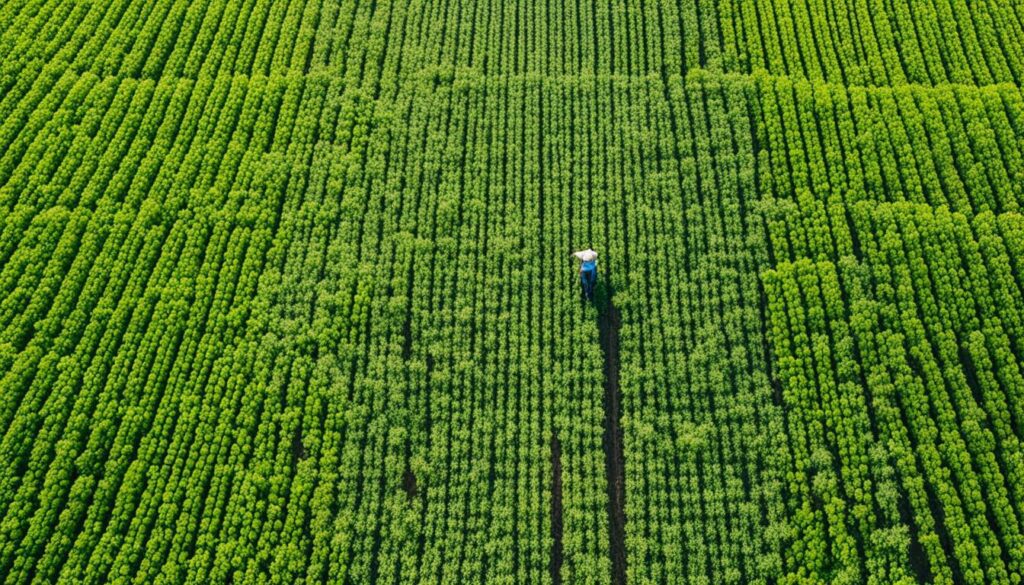
A study by UC Davis in California showed how cover crops help the soil. Examining 10 farms, they found these crops made the soil richer. They increased the organic matter, nitrogen, and activity of tiny soil creatures. This is clear proof they make the soil healthier.
Rye and vetch, two common cover crops, are also great for keeping the soil full of nutrients. They do this without taking too much water from the main crops. These plants can also stop weeds because they cover the ground well.
Across the world, studies have found that cover crops are good at keeping water in the soil. They can store more rain and keep the soil wet for longer. This is good news for farmers as it means their fields can hold onto water better.
Growing cover crops along with not digging the soil too much can save even more water. It keeps the soil cool. This not only helps the main crops grow better but also helps the soil to keep more moisture. It’s a win-win.
| Benefit | Finding |
|---|---|
| Soil Fertility Improvement | Increased organic matter, nitrogen, and microbial activity |
| Moisture Retention Enhancement | Better water infiltration and retention |
| Weed Suppression | Greater biomass and ground cover |
| Temperature Regulation | Cooler soil and surface air temperatures |
Choosing drought-tolerant crops and using water-conserving plants are key in water management for farming. Agriculture uses a lot of the world’s fresh water, around 70%. It’s vital to pick crops that need less water, especially in places like the United States where irrigation takes up lots of fresh water.
In 2017, the amount of water used for irrigation in the U.S. dropped. This shows that using water smarter works. Nebraska leads in using irrigation wisely, with a big area irrigated in 2017. This suggests success in focusing irrigation where it’s most needed.
California, another big farming area, has reduced its irrigated land. This means choosing the right crops is crucial, especially plants that can survive with less water. For example, corn covered a vast area in 2017 but could do even better with special breeding for drought.
Using varied crops known for not needing a lot of water promotes farming that lasts. Farms with different plants can handle change in weather, pests, and low water better. Diverse plants also keep the soil healthy and hold more water, helping all crops do well.
Also, high-tech farming tools and smart watering systems are making a big difference. They let farmers use water only where and when it’s truly needed, saving water. This smart way of farming is key not just for saving resources but also for making sure we have enough food while protecting the earth.
| State | Irrigated Land (million acres) | Percentage of U.S. Irrigated Cropland |
|---|---|---|
| Nebraska | 8.6 | 14.8% |
| California | 7.8 | 13.4% |
Using rotational grazing is key for better pasture and soil health. It helps manage livestock wisely and makes crop-livestock systems better. This method aids in waste reduction and improved water use.
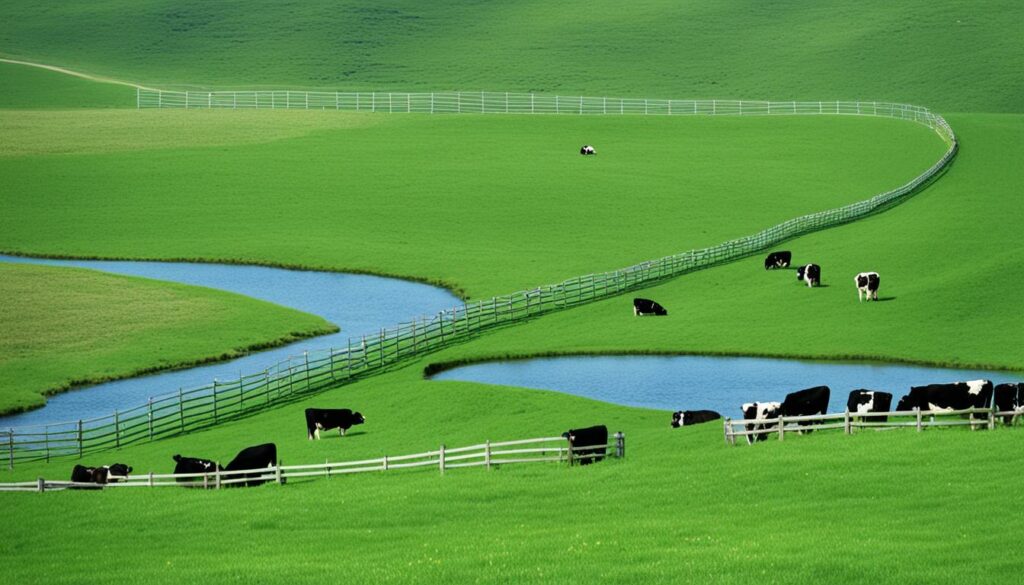
Rotational grazing helps in many ways. It improves the quality and fertility of pasture. It shows in the field too, with more dry matter grown per acre.
Farmers can have 2 tons more per acre this way. It avoids overgrazing and boosts forage growth, up to 70%. Livestock moving around also keeps plant roots deep, which helps the soil stay healthy.
This way of grazing also lessens land damage and keeps water clean. It’s good for keeping farms healthy and the environment safe.
Pairing this style with growing crops has big upsides. It does good for the land by managing water better. This helps during droughts, saving money on water use.
In places like the Midwest, farmers use this well. It makes their pastures better. This mix also cuts down on using harmful chemicals, which saves money and helps the earth. Plus, it cuts back on gases that harm our atmosphere.
| Benefits of Rotational Grazing | Impact |
|---|---|
| Increased Forage Production | 30-70% increase with proper management |
| Enhanced Soil Health | Boosts soil biomass and deeper plant roots |
| Improved Irrigation Efficiency | Cost-effective and aids in drought management |
| Reduced Pesticide Use | Lower associated costs, higher profit margins |
| Environmental Benefits | Reduces greenhouse gas emissions |
In the search for better irrigation water management, water retention agents are key. They make soil hold more water. This helps with farming in a world facing more water scarcity.
Two standouts in this area are Verdesian water retention products: Safe Zone™ and Aqua-Pam™. They boost seed growth, water flow, and how plants take in food. They make soil better, curb soil loss, and boost water holding. These benefits are great for crop growth and managing water.
Water agents like Safe Zone™ and Aqua-Pam™ make managing water better. They get water to plant roots more efficiently. This means you water less but grow more. It’s a big help against water scarcity.
| Product | Benefits |
|---|---|
| Safe Zone™ | Enhances germination, improves water percolation, supports nutrient uptake, boosts soil structure, and controls erosion. |
| Aqua-Pam™ | Improves irrigation efficiency, enhances water-holding capacity, supports soil conditioning, and reduces erosion. |
Using Verdesian water retention products marks a turning point in irrigation water management. It saves a lot of water and helps farms last longer.
Using water wisely in farming is key to managing water sustainably and looking after our water supplies. Modern irrigation systems are a big help. They save a lot of water, which is great for the environment.
Drip and pressurised irrigation are changing how we use water in farming. Drip irrigation, for example, cuts water use by 30 to 70%. At the same time, it boosts crop yields by 30 to 200%.
From 1969 to 2017, the amount of water used for irrigation in the U.S. dropped. This shows how effective these systems can be. The average water use went down from over 2 acre-feet to under 1.5 acre-feet per irrigated acre.
Looking at real-life examples, we can see how well these systems work. In 2017, Nebraska had more irrigated land than any other state, with 8.6 million acres.
Also, by 2018, over 72% of the west’s irrigated land used pressurised systems. This was up from 37% in 1984. These facts show that more and more farmers are choosing efficient methods to water their crops.
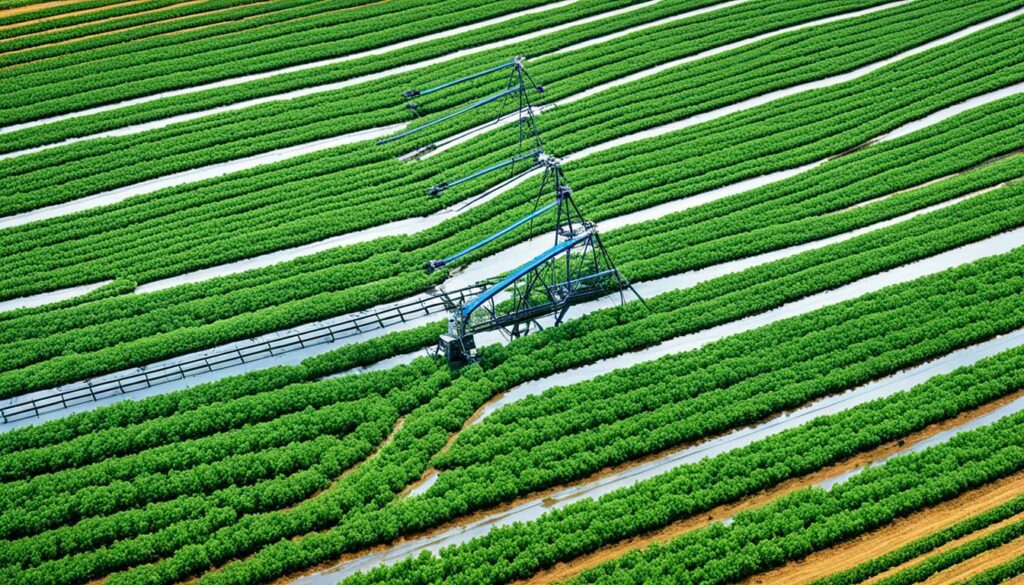
These examples highlight the growing importance of managing water well in agriculture. Using water efficiently helps us farm better without harming the environment. It’s a win-win for everyone.
| Year | Statistics |
|---|---|
| 2015 | Irrigation accounted for 42% of the total freshwater withdrawals in the U.S. |
| 2017 | Farms with irrigation represented over 54% of the total value of U.S. crop sales. |
| 2017 | Corn accounted for the most irrigated acreage in the U.S. with over 12 million irrigated acres harvested. |
| 2018 | Over half of all water for irrigation came from surface water, with the remaining sourced from groundwater. |
To keep our water lasting for future generations, we must farm in smart ways. By using the best irrigation systems and following successful examples, we can farm productively and protect the planet. It’s about farming in a way that looks after our water and our land.
The Phytobac system is a new way to protect our water from harm. It stops 15,000 litres of liquid waste every year from polluting our water. For it to work well, the area it covers must be between 29.6m2 to 41.5m2, based on how much shade the area gets.
Phytobac systems use drip irrigation with specific spacing and a set number of drip points. It requires careful pressure control to make sure all the plants get enough water but don’t flood. This attention to detail means these systems help preserve our water sources.
The system needs the right amount of water in the biomix to work correctly. If the moisture level is over 70% or under 60%, it won’t do its job well. In Spain, 19 Phytobac systems help protect water near citrus, fruit, and grape farms.
For example, the Agrimarba farm uses a large Phytobac system to handle waste from its 110-hectare citrus area. At a recent seminar, Dr. Patricia Chueca praised the Phytobac system. She said it’s good for the environment because it follows laws about using pesticides safely.
People around the world want farming that’s not harmful to nature. Phytobac systems help meet this demand by keeping our water clean. They are a smart and safe choice for the planet.
| Parameter | Details |
|---|---|
| Annual Capacity | 15,000 litres |
| Surface Area | 29.6m2 to 41.5m2 |
| Emitter Spacing | 0.4 x 0.4m |
| Drip Lines Pump Pressure | 7m head (10m total) |
| Biomix Moisture Content | 60-70% |
| Systems in Spain | 19 |
In conclusion, using water wisely in farming is key. It meets farm needs now and saves water for the future. 70% of the world’s fresh water is used in farming. This shows we must save water in agriculture. For instance, 3,000 litres are needed daily to grow food for one person.
To feed more people by 2050, we’ll use more water. So, we must farm smarter. Using water on crops can double their yield. Tools like the SPIS Toolbox help farmers manage water better. They suggest where to put pipes and how to test soil. This boosts how well we use water.
Better ways to water plants, like drip systems, help save water. They make sure plants get the right amount of water. This saves water and helps plants grow well. As the world gets warmer and climates change, farming must adapt. By picking the right crops and using modern water-saving ways, we can protect farming’s future.
Drip irrigation is great for saving water in farming. It lowers water evaporation and nutrient loss. It’s a smart way to use water efficiently in agriculture.
Technologies like drones and sensors help farmers fine-tune their irrigation. They also give planting advice and check soil water levels. This makes farming more water-wise.
Building reservoirs, dams, and ponds is key. They secure water when it’s dry and lessen the need for new water sources.
It’s crucial to know when and how much crops need water. Modern tools like moisture sensors and weather predictions help. They make irrigation more efficient.
Improving soil with compost and mulch helps it hold more water. Not tilling much stops water from running off. Both save water.
Dry farming is for places with little water. It uses careful planting and soil prep to use every bit of available water well.
Cover crops make the soil richer and hold more moisture. This saves water and helps in dry times.
Picking plants that need less water helps manage water better. It leads to sustainable water use in farming.
Rotational grazing keeps pastures and soil healthy. It mixes crops and animals well. This helps use water wisely in farming.
Products like Safe Zone™ and Aqua-Pam™ make soil hold more water. This helps irrigation work better, saving water.
Drip irrigation, sprinklers, and sub-surface watering are key. They improve water use in farming well. These methods help take good care of water in agriculture.
Phytobac systems break down chemicals from fields. They stop water pollution, keeping the environment safe and clean.